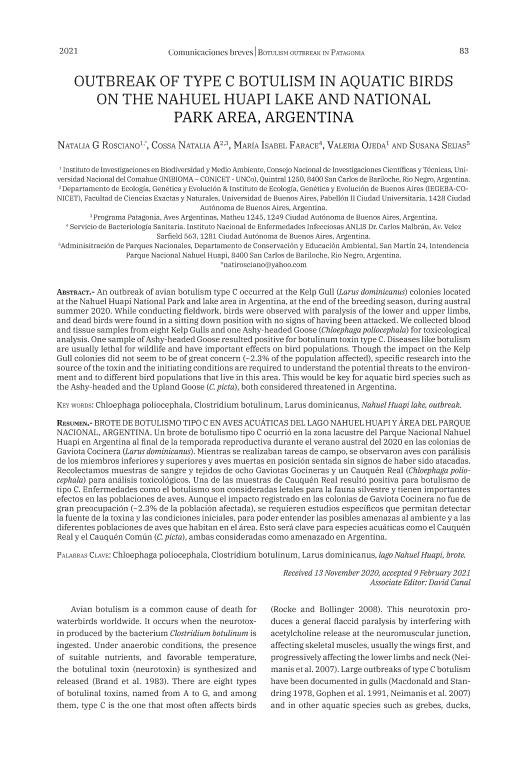Artículo
An outbreak of avian botulism type C occurred at the Kelp Gull (Larus dominicanus) colonies located at the Nahuel Huapi National Park and lake area in Argentina, at the end of the breeding season, during austral summer 2020. While conducting fieldwork, birds were observed with paralysis of the lower and upper limbs, and dead birds were found in a sitting down position with no signs of having been attacked. We collected blood and tissue samples from eight Kelp Gulls and one Ashy-headed Goose (Chloephaga poliocephala) for toxicological analysis. One sample of Ashy-headed Goose resulted positive for botulinum toxin type C. Diseases like botulism are usually lethal for wildlife and have important effects on bird populations. Though the impact on the Kelp Gull colonies did not seem to be of great concern (~2.3% of the population affected), specific research into the source of the toxin and the initiating conditions are required to understand the potential threats to the environment and to different bird populations that live in this area. This would be key for aquatic bird species such as the Ashy-headed and the Upland Goose (C. picta), both considered threatened in Argentina. Un brote de botulismo tipo C ocurrió en la zona lacustre del Parque Nacional Nahuel Huapi en Argentina al final de la temporada reproductiva durante el verano austral del 2020 en las colonias de Gaviota Cocinera (Larus dominicanus). Mientras se realizaban tareas de campo, se observaron aves con parálisis de los miembros inferiores y superiores y aves muertas en posición sentada sin signos de haber sido atacadas. Recolectamos muestras de sangre y tejidos de ocho Gaviotas Gocineras y un Cauquén Real (Chloephaga poliocephala) para análisis toxicológicos. Una de las muestras de Cauquén Real resultó positiva para botulismo de tipo C. Enfermedades como el botulismo son consideradas letales para la fauna silvestre y tienen importantes efectos en las poblaciones de aves. Aunque el impacto registrado en las colonias de Gaviota Cocinera no fue de gran preocupación (~2.3% de la población afectada), se requieren estudios específicos que permitan detectar la fuente de la toxina y las condiciones iniciales, para poder entender las posibles amenazas al ambiente y a las diferentes poblaciones de aves que habitan en el área. Esto será clave para especies acuáticas como el Cauquén Real y el Cauquén Común (C. picta), ambas consideradas como amenazado en Argentina.
Outbreak of type C botulism in aquatic birds on the Nahuel Huapi Lake and National Park Area, Argentina
Título:
Brote de botulismo tipo C en aves acuáticas del Lago Nahuel Huapi y área del Parque Nacional, Argentina
Rosciano, Natalia Gimena ; Cossa, Natalia Andrea
; Cossa, Natalia Andrea ; Farace, María Isabel; Ojeda, Valeria Susana
; Farace, María Isabel; Ojeda, Valeria Susana ; Seijas, Susana
; Seijas, Susana
 ; Cossa, Natalia Andrea
; Cossa, Natalia Andrea ; Farace, María Isabel; Ojeda, Valeria Susana
; Farace, María Isabel; Ojeda, Valeria Susana ; Seijas, Susana
; Seijas, Susana
Fecha de publicación:
08/2021
Editorial:
Asociación Ornitológica del Plata
Revista:
El Hornero
ISSN:
0073-3407
e-ISSN:
1850-4884
Idioma:
Inglés
Tipo de recurso:
Artículo publicado
Clasificación temática:
Resumen
Archivos asociados
Licencia
Identificadores
Colecciones
Articulos(IEGEBA)
Articulos de INSTITUTO DE ECOLOGIA, GENETICA Y EVOLUCION DE BS. AS
Articulos de INSTITUTO DE ECOLOGIA, GENETICA Y EVOLUCION DE BS. AS
Articulos(INIBIOMA)
Articulos de INST. DE INVEST.EN BIODIVERSIDAD Y MEDIOAMBIENTE
Articulos de INST. DE INVEST.EN BIODIVERSIDAD Y MEDIOAMBIENTE
Citación
Rosciano, Natalia Gimena; Cossa, Natalia Andrea; Farace, María Isabel; Ojeda, Valeria Susana; Seijas, Susana; Outbreak of type C botulism in aquatic birds on the Nahuel Huapi Lake and National Park Area, Argentina; Asociación Ornitológica del Plata; El Hornero; 36; 1; 8-2021; 83-88
Compartir



